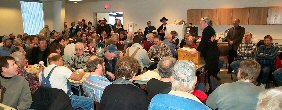 NARFI Director Timlynn Babitsky met recently with MSU-Northern Library Director Cynthia Harrison to contribute a bookshelf of books and a CD-ROM to bolster the university's information resources about renewable energy. MSU-N students, faculty, and citizens throughout northcentral Montana are encouraged to use these materials to envision and implement Montana's alternative energy future.
NARFI Director Timlynn Babitsky met recently with MSU-Northern Library Director Cynthia Harrison to contribute a bookshelf of books and a CD-ROM to bolster the university's information resources about renewable energy. MSU-N students, faculty, and citizens throughout northcentral Montana are encouraged to use these materials to envision and implement Montana's alternative energy future.Information, Inspiration, and Ideas for a Sustainable Rural Future
Promoting the Entrepreneurial Community Spirit
The North American Rural Futures Institute
Emerging Technologies Category-specific Content
NARFI Donates Renewable Energy Books to MSU-N Library
 NARFI Director Timlynn Babitsky met recently with MSU-Northern Library Director Cynthia Harrison to contribute a bookshelf of books and a CD-ROM to bolster the university's information resources about renewable energy. MSU-N students, faculty, and citizens throughout northcentral Montana are encouraged to use these materials to envision and implement Montana's alternative energy future.
NARFI Director Timlynn Babitsky met recently with MSU-Northern Library Director Cynthia Harrison to contribute a bookshelf of books and a CD-ROM to bolster the university's information resources about renewable energy. MSU-N students, faculty, and citizens throughout northcentral Montana are encouraged to use these materials to envision and implement Montana's alternative energy future.Cattle rustlers beware....
Cattle brands are a big deal. They have been historically and they are today. A brand on an animal identifies who owns it, and in many cases, the history of the animal as it is sold from one ranch to another. Keeping track of brands and the owners of those brands is a huge challenge in major ranching states like Texas, Montana, Colorado, Wyoming, Nebraska, and New Mexico.
For example, in New Mexico alone, there are nearly 29,000 brands representing thousands of working ranches, each of which may use several different brands. Brands are currently kept in huge books that are referenced to locate the exact drawing of a brand and the ranch that owns it. This is terribly time consuming and vulnerable to misinterpretation and error.
The challenge is already huge, but will grow even larger as federal livestock identification regulations take effect in the next couple of years. There is also a great deal of pressure to develop a system that can track the origin of ill animals within 48 hours.
A New Mexico software developer, Nickel Brand Software, may have a good part of the answer to the cattle identification and tracking problem.Nickel Brand Software allows a user to find the ownership of a branded animal within minutes, not days. The digital livestock identification software allows the user to either sketch the brand on a hand held computer palm pad or to scan the brand with a hand scanner. The brand database is then accessed and the brand owner is quickly identified. Click here for more general information. Click here for more details about the software.
Workshop on Wind Power Draws Big Turnout
 Over 250 people filled the community meeting room and spilled into nearby hallways of the Hill County Electric Co-op to attend the USDA Farm Bill Wind Power Workshop. Folks came to learn about an emerging renewable 'crop' to be harvested in northcentral Montana. This reprint of the Havre Daily News story is enhanced with NARFI photos and links to on-line versions of the presentations from the workshop.
Over 250 people filled the community meeting room and spilled into nearby hallways of the Hill County Electric Co-op to attend the USDA Farm Bill Wind Power Workshop. Folks came to learn about an emerging renewable 'crop' to be harvested in northcentral Montana. This reprint of the Havre Daily News story is enhanced with NARFI photos and links to on-line versions of the presentations from the workshop.Stinky power ...
Industrial and municipal wastewater treatment facilities with anaerobic gas digesters are an untapped power source for hospitals, schools, universities, hotels and other commercial and industrial facilities. The methane generated from the anaerobic gas digestion process is used as fuel for Direct FuelCells (DFC).
"Direct FuelCells are like large, continuously operating batteries that generate electricity as long as fuel, such as natural gas, is supplied. Since the fuel is not burned, there is no pollution commonly associated with the combustion of fossil fuels...This high-efficiency technology generates more electric power from less fuel and with less carbon dioxide emissions than traditional methods using combustion."
A 500 kW fuel cell project will be installed at Santa Barbara's El Estero Wastewater Treatment Plant. It will harness methane gas from the anaerobic digesters as the fuel source. FuelCell Energy, Inc., and Alliance Power have formed a joint venture to sell electric power and heat to the facility under a long-term power purchase agreement - the first of its kind for FuelCell Energy.
Alliance Power is the turnkey provider to the project and FuelCell Energy will provide the DFC power plants and operations and maintenance services. The 650-degree Fahrenheit exhaust from the power plants will be used to supplement heating of the anaerobic digesters that create the methane gas for use by the fuel cells. The power plants are expected to be delivered and operational in the fourth quarter of 2004.
In a market study conducted in 1998, over 550 municipal wastewater treatment facilities in the U.S. were identified to be capable of producing enough methane from anaerobic gas digestion to fuel a 250-kilowatt or larger Direct FuelCells power plant.
No lightbulbs in 10 years?
Give up the gas!
New Entries in Rural Futures Directory
 A number of Wind Power entries were recently added to the NARFI Rural Futures Directory. Especially interesting are the educational resources for teachers who want to add wind power topics to their curricula. To see the newest teachers' wind power resources visit this page.
A number of Wind Power entries were recently added to the NARFI Rural Futures Directory. Especially interesting are the educational resources for teachers who want to add wind power topics to their curricula. To see the newest teachers' wind power resources visit this page.Wind and Biodiesel Energy In Our Rural Future
 NARFI sent recent MSU-Northern graduate, Kristie Smith of US Bank on the Montana Secretary of State's Energy fom the Farm Bus Tour to deepen our local community knowledge about wind power and biofuels. As our first mini-grant recipient, Kristie is spotlighted as a NARFI Futures Thinker. We invite you to read Kristie's trip report as she reflects on the whirlwind tour of alternative energy projects and applications in and around Montana.
NARFI sent recent MSU-Northern graduate, Kristie Smith of US Bank on the Montana Secretary of State's Energy fom the Farm Bus Tour to deepen our local community knowledge about wind power and biofuels. As our first mini-grant recipient, Kristie is spotlighted as a NARFI Futures Thinker. We invite you to read Kristie's trip report as she reflects on the whirlwind tour of alternative energy projects and applications in and around Montana.